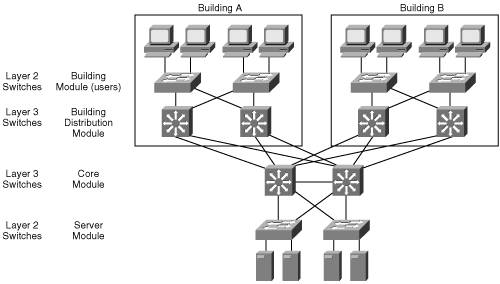Switching Design Considerations
| Chapter 1, "Network Design," introduces the hierarchical network design model and the Enterprise Composite Network Design model. Recall that the three functions that comprise the hierarchical network design model are the access layer, the distribution layer, and the core layer. The Enterprise Composite Network Model is the name given to the architecture used by the Cisco SAFE blueprint; it supports larger networks than those designed with only the hierarchical model and clarifies the functional boundaries within the network. Three functional areas exist within this model: Enterprise Campus, Enterprise Edge, and Service Provider Edge. Each of these functional areas contains network modules, which in turn can include the hierarchical layers. Switches within the Enterprise Campus are in all three of the hierarchical layers. Layer 2 and/or Layer 3 switches can be used, depending on a number of factors. For the access layer, design considerations include the following:
For the distribution layer, design factors include the following:
The role of the core layer is to provide a high-speed backbone. Thus, the key requirement is the performance needed to support all the access and distribution data. The number of ports to the distribution layer, and the protocols (for example, routing protocols) that need to be supported on those ports, are also important considerations. Redundancy in the core is a typical requirement, to meet the availability needs of the network. Cisco current campus design recommendations include the following:[9]
Figure 2-12 illustrates a sample small network design that uses Layer 2 switches in the access layer of the campus Building and Server modules. This network features a collapsed backbone in Layer 3 switches. Redundancy is incorporated between all layers. Figure 2-12. A Small Network Can Include a Collapsed Backbone Figure 2-13 illustrates an example of a larger network design. Two buildings are shown, each with Layer 2 access switches and Layer 3 distribution switches. These buildings are then redundantly connected to the Layer 3 core. The Server module is shown with Layer 2 access switches connected directly to the core; distribution switches can be added if additional functionality or performance is required. Figure 2-13. A Larger Network Has Separate Core and Distribution Switches |
EAN: 2147483647
Pages: 156
